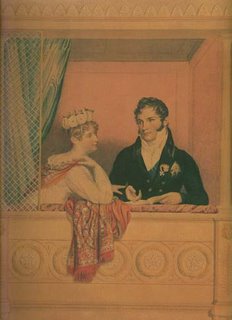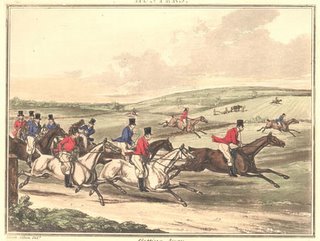Like Laurie, I’ve been scrambling to finish my packet of RITA books, figure out the difference between a 5.8 book and a 6.2 one (decimals confuse me), and get the scores sent off on time. Therefore, my post this week is something rather lazy, but, I hope, kind of interesting for “Regency geeks” like myself.
Last week in the “New York Times”, I read an article titled “Furniture of the Regency, an era of high whimsy, to be auctioned in London.” It concerns the estate of Maurice Turpin, a London antiques dealer, which is being sold by Christie’s next week. Over 900 lots of furniture, objets, bibelots, etc. Including a Davenport writing desk, a Canterbury music stand, a worktable with little spaces for sewing supplies, a Regency wine cooler modeled on an ancient sarcophagus, and an ivory Indian tea caddy (the only object that had a picture–I tried to scan it, but it didn’t work). I was almost drooling just thinking about all those wondrous goodies I can’t afford!
The article, along with details of the sale, also had some interesting historic tidbits. Like these:
“It was a world as fashion conscious as our own. When the Prince Regent changed his mealtimes, his admirers followed. Breakfast was served as a buffet from 10 am until noon, which led to the introduction of the breakfast room, often one fitted with breakfront side cabinets whose grilled doors were lined with pleated silk panels, another new fashion”
“Separate rooms were provided for listening to music, playing indoor games like billiards, and viewing paintings and sculpture. Conservatories were attached to living rooms so that guests could easily enjoy hothouse plants like orchids and cactuses” (This makes me want to write a scene where the villain gets pushed into that cactus, and emerges with spines stuck in his butt!)
“The library was often not just the principal room, but was distinctively and comfortably furnished with a variety of tables for specific purposes–sofa tables, writing tables, reading tables, bookstands, games tables…” (Examples of all of these are in the sale)
“The dining room also had its own distinct types: a table could be extended with endless spare leaves, serving tables, wine tables, and monumental sideboards, often built in. When the Prince Regent moved his dinnertime from 3 pm to sometime from 6 to 7 pm, gaslights and Colza oil lamps and twin-light candelabra were used to increase the illumination in the dining room”
The article concludes by saying “For those who want to learn more (about English Regency furniture), the Sir John Soane’s Museum Foundation in New York is offering a four-part seminar on Regency furniture and architecture” (http://www.soanefoundation.com) I would efinitely take advantage of this if I just lived in NY!
So, what I wonder now is this: if money was no object, what items would you like to own from the Regency? I’d love to have one of those sofas with tacky, Egyptian-style feet, plus that wine cooler. And maybe a nice little tea caddy. And my very own quizzing glass.







